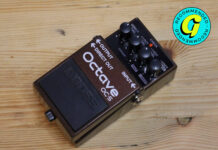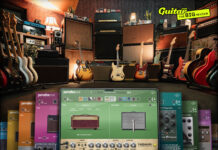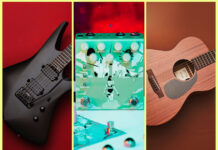
14 best multi-effects pedals to buy in 2019
“Multi-effects pedal” is no longer a dirty term. Thanks to powerful processors and DSP capabilities, what were formerly shrill, cold-sounding units have matured into all-in-one boxes capable of producing authentic effects and spot-on amp simulations. It’s little wonder that many guitarists are swapping out dedicated stompboxes for these multi-talented devices.
But which is the best multi-effects pedal for you? That really depends on your needs – whether you plan to deploy it on the stage, in the studio or as a supplement to an existing pedalboard. So in compiling this list, we’ve looked at three factors that are important, no matter the context: sound quality, range of effects available and customisability.
Eventide H9 Max Harmonizer
While Eventide’s H9 Max Harmonizer is reminiscent of HAL 9000, we assure you it isn’t out to murder you. It does, however, have killer, studio-quality sound, a wealth of onboard effects, and deep programmability to appease even the most critical tone snob. The H9 Max may very well be the desert-island pedal for sessionists and studio musicians.
The H9 Max loads its algorithms from Eventide’s TimeFactor (delay), ModFactor (modulation), PitchFactor (pitch shifting), and Space (reverb) pedals, as well as a few designed specifically for it – there are 49 algorithms in total.
These include standard ones such as chorus, phaser, overdrive/distortion and vibrato, but also far-out ones like a pitch-shifting, delayed fuzz and the Space’s acclaimed BlackHole. So the H9 feels right at home on your rendition of Black Dog as it does on any Tom Morello lick. And needless to say, these algorithms sound identical to those on the full-sized pedals.
In terms of controls, you only have one knob and five buttons to summon all those sounds. But they’re streamlined enough: The X, Y, and Z buttons each activate a particular parameter, whose value can then be adjusted via the dial. These are just the ‘top-level’ parameters on each effect that Eventide believes to be the most commonly accessed. Bringing up the others requires some button-mashing action. To toggle between presets or algorithms, hit the Presets buttons and begin scrolling with the big dial.
The real magic of the H9 Max lies in Eventide’s H9 Control app. Think of this as the ‘command centre’ for the stompbox. It lets you load and create presets, manage parameters, and even control the H9 remotely via Bluetooth. The app is also the home for the tonne – more than 500 – of presets and algorithms that you can download.
Retails for $699/£639. Read our full review here.
Line 6 HX Stomp
The smaller sibling to Line 6’s HX Effects, the HX Stomp is a compact programmable unit brimming with amp and cab sims, effects as well as impulse response (IR). The HX Stomp’s array of capabilities makes it well-suited to different usages. You can deploy it as a ‘super stompbox’, an add-on for other modellers, an audio interface or as a main guitar rig.
Powering the HX Stomp is Line 6’s acclaimed DSP and HX Modelling technology, which were both used for the brand’s flagship Helix guitar processors. As for tone options, you won’t be left wanting: the unit arrives with over 300 sonic choices spanning amps, cabs, and effects. There’s also a treat for fans of Line 6’s legacy effects, with the brand porting over effects from its M-series pedals along with four classic stompbox modelers: DL4, MM4, FM4, and DM4. Topping the feature set are a vividly coloured LCD screen and three capacitive-sensing footswitches featuring LED rings.
Retails for $559/£558. More info here.
Line 6 M5
The M5 is the smallest member of Line 6’s M-series multi-effects floor units. Don’t be fooled by its size, however, as it still offers more than a hundred M-series type effects, including crunching distortions, lush choruses, plenty of ’verb and classic delays. The latter two categories are both stocked with effects from Line 6 favourites such as the Verbzilla and DL4.
Despite the wealth of tone choices at hand, the M5 boasts a user-friendly control system. There’s a Model Select knob – with a push function to save the current setting – that helps you navigate all the effect libraries and make your selection. This control is complemented by five parameter knobs, represented on a brightly lit screen, that lets you sculpt the selected effect. Last but not least, pressing down on the Tap knob brings up a tuner – handy for those on-the-fly tuning situations.
Retails for $169/£174.99.
Boss MS-3
If you’re on the hunt for an effects loop switcher with a quality multi-effects engine, look no further than Boss’ MS-3. Although the device stands out as a routing workhorse – it has three independent effects loops – it also fills in the gaps for effects that you may be lacking. MS-3 boasts over a hundred effects spanning conventional types like OD and reverb on top of unique options such as Slicer and Slow Gear. What’s more, you can deploy six of these simultaneously in a patch.
And while the MS-3 can fill the gaps in your current rig, it does require some planning – especially if you’re thinking about using it in a live performance. A limitation with the MS-3 is the inability to change the sequence of the loops, so chart your signal paths carefully.
Thanks to the large LCD screen, navigating the many effects menus is relatively painless. It may take you a few tries if you’re unfamiliar with Boss’ user interface, but you’ll get there quickly. Alternatively, you can also hook the unit up to the computer via USB and use Boss’ free editor software to plan your presets.
To tie things up, the MS-3 also has a wide array of I/O options at the back, including MIDI and expression control. Once you’ve set it up to your liking, you’re going to love how the MS-3 integrates with your rig.
Retails for $559/£439.
Tech 21 Fly Rig 5
Released in 2014, Tech 21’s Fly Rig earned plaudits for offering great tone in a slimmed-down pedal format. Besides its wealth of effects, the original Fly Rig’s star feature was the all-analogue SansAmp technology, which gave it the sound and feel of a real stompbox.
With the fifth version of the pedal, Tech 21 has updated the original Fly Rig recipe with an independent reverb – which lets you modify room sizes – a tuner, an XLR output as well as an effects loop. This gives it a total of five effects. The SansAmp technology has, of course, been retained, alongside familiar options such as the Plexi/Cali crunch option along with the vintage tape echo features tap tempo.
Retails for $350/£299.
NUX MG-100
The NUX MG-100 is an entry-level multi-effects processor that’s tailored to beginner guitarists. And it has a price tag to match: it’s only $100.
It gives you a taste of effects-chaining by letting you pick out eight effects – from a total of 58 – and have them engaged simultaneously. The pedal’s effects library includes your customary drives, reverbs, modulations and delays alongside utility options such as a compressor, a six-band EQ as well as a noise gate.
In addition to the 58 effects, the MG-100 also arms you with 13 amp and 11 cabinet emulations. You’ll have a choice of classics – such as tweed Fenders, an AC30 and a JCM800 – as well as a curiously named “Death Zone” amp model.
The MG-100 doesn’t only excel in the effects and amp/sim categories – its in-built drum machine and looper make it great for gigging and practice, too. The former equips you with 56 rhythm patterns, while the latter allows unlimited overdubs of 40 seconds each. With these in tow, practice should be a breeze.
Retails for $99.
Behringer FX600
It’s probably a surprise to see this one on a list of best multi-effects pedals. But for the price of four packs of strings, Behringer’s FX600 is one of the most value-for-money stompboxes – let alone multi-effects units – you can find.
The pedal arms you with six modes – flanger, chorus, phaser, delay, tremolo and pitch shifter – but there are no drive or ’verbs available. They’re all digital effects, though, so expect them to be clear, bright and a tad shrill. And you can only run one effect at a time.
Unlike other multi-fx units on this list, the FX600 doesn’t have an LCD screen. It does, however, feature a user-friendly layout of four controls, which includes an output knob, two parameter knobs as well as a mode selector. The two parameter knobs have contextual functions that differ from effect to effect. For example, in the pitch shifter mode, Parameter 1 adjusts the higher octave while Parameter 2 tweaks the lower octave. But when you’re on the phaser, chorus or flanger, the former adjusts the effects’ speed, and the latter their depth.
Retails for $39.99/£29.99.
Kemper Profiler Stage
Since its release seven years ago, Kemper’s Profiler amp has set the benchmark for digital modelling amps. And at Summer NAMM in July, the German company repackaged its flagship product as a floor unit: the Profiler Stage.
Like its larger sibling, the Profiler Stage is a fully fledged multi-effects unit and amp modelling beast. The new device features Kemper’s game-changing Profiling technology – touted to replicate the sound of any amp – along with an exhaustive library of real-world amp profiles.
As for controls, the floorboard unit sports five preset buttons – that grant access to your rigs – and four buttons that trigger up to four effects (or groups of effects) within a chosen rig. There are nine classes of effects, ranging from distortion to wah to pitch shifters, with several modes in each class. Many of these are, like the amps, based on real units, which include Tube Screamers, UniVibes and even a Fender spring reverb tank from 1963.
These effects are complemented by a tuner, looper, effects loop and tap tempo feature. You’ll also be able to easily view all your changes on stage via the Profiler Stage’s smart two-colour display, which automatically tunes the contrast and brightness settings to your environment.
Retails for $1,700/£1,450. More info here.
Zoom G1X Four
The G1 Four (left) and G1X Four (Right)The G1X Four is the latest entrant in Zoom’s G-series Multi-Effects line. This pedalboard-friendly unit boasts over 70 effects ranging from traditional types to more eccentric ones such as ring modulation, pitch-shifting delay and sitar simulation. It also features 13 amp and cab sims, which include emulations of classic Fender, Marshall and Orange models.
On the utility side, the G1X Four comes with an expression pedal and two in-built components: a looper and a drum machine. The looper arms you with up to 30 seconds of recording, while the drum machine gives you 68 rhythm patterns that come in various time signatures.
Retails for $99.99/£85. More info here.
Zoom G3Xn
Despite missing out on some of the newer features in the G1X Four, the G3Xn still has a catalogue of versatile attributes that merit its inclusion in this list. It’s larger, too, with three stomp pads and sets of controls compared to the G1X Four’s two.
Like its newer counterpart, this pedal features 70 high-quality digital effects that span distortion, overdrive, EQ, compression as well as more obscure types such as Seq Filter, Reverse Delay and OSC Echo.
In addition to its effects library, the G3Xn also features 10 of the “most realistic” amp and cab emulations that Zoom claims to have ever crafted. Highlights include a Marshall JCM800, Fender Twin Reverb and Mesa Boogie Mark III 1×12 cab.
In the same vein as the G1X Four, the G3Xn also features a drum machine – with 68 rhythm patterns – an expression pedal and an in-built looper, with a longer capacity of up to 80 seconds per loop.
Retails for $219.99/£139.
Boss GT-1000
The GT-1000 is regarded as Boss’ top multi-effects unit, and for good reason. It features the brand’s proprietary AIRD technology, a wide gamut of amp models and a suite of effects algorithms taken from the DS-1, DD-500 Digital Delay, MD-500 Modulation and RV-500 Reverb.
At the heart of the GT-1000 is Boss’ AIRD (Augmented Impulse Response Dynamics technology), which is also used in the Tube Logic software found in the brand’s Katana amps. This piece of tech mimics the interactivity and complexity of tube amps and, in the GT-1000, balances out dynamics between all the other components in your signal chain. The result: you can use the processor with any amp and still nail the same results.
What’s unique about the GT-1000 is its method for handling effects and amp models. Rather than individual effects, the device relies on patches, which are the sum of effects, amps and their corresponding parameters. You won’t be able to configure your signal chain in the traditional sense, but the upside is the ability to string together extremely sophisticated chains and toggle between them at the stomp of a footswitch.
Thankfully, the floorboard sports 10 footswitches, six contextual knobs and a large display to help you create and recall patches. Or, fire up the Boss Studio app to design everything on your computer or mobile device. Meanwhile, a suite of I/Os – including MIDI, XLR and two effects loop – is sufficient for most studio and stage needs.
Retails for $999.99/£737. More info here.
T-Rex SoulMate
As its name suggests, this multi-effects pedal combines four of the boutique Danish brand’s most beloved effects into a single unit. These include the Møller overdrive, Mudhoney distortion, Replica/Reptile modulated delay and Room-Mate reverb. There’s also a boost option that arms you with up to 14dB of additional volume.
T-Rex’s focus is on tone quality, and you’ll be hard-pressed to find a multi-effects pedal that sounds as good as this. Each effect has its own dedicated footswitch and suite of controls, which resemble those on the actual stompboxes, for easy operability. And the rightmost switch serves as both a tap tempo for the delay and to call up the tuner – very handy on stage.
You can use the SoulMate in one of two modes: live or preset. The former sets the board as five individual pedals that can be customised on the fly. And the latter lets you toggle between 10 presets (in two banks of five), which can either be individual effects or a chain of them.
Retails for $599/£399.
Mooer GE300
One of the highlights of Winter NAMM 2019 was Mooer’s GE300 multi-effects processor. The latest in the Chinese brand’s GE line, this unit arrives with an impressive 108 digital amp models, 43 IR-based cab sims and 164 effects.
What sets the GE300 apart from its peers, however, is a three-voice polyphonic synth module designed to turn your guitar into a synth. Each module’s voice can be tweaked according to your selection of waveform, pitch, filters and arpeggiators.
The GE300 also features Mooer’s Tone Capture modelling system, a popular feature from the brand’s Preamp Live Amp modeller. Tone Capture has three modes: Amp, Guitar and Cab. The first lets you sample and capture your own amp’s character, the second enables you to model your instrument’s EQ profile, while the third gives you the ability to sample speaker cabs in order to create your very own IR files.
Retails for £749.99. More info here.
HeadRush Gigboard
HeadRush’s Gigboard is a petite version of the Pedalboard, the brand’s flagship multi-effects processor that was released two years ago. Other than its portable form factor, the newer device retains many of its predecessor’s features – it has the same quad-core processor, Eleven HD Expanded DSP software and seven-inch touchscreen.
On the effects front, the Gigboard features HeadRush’s comprehensive library of over a hundred amp, cab and mic emulations – these range from Plexis and tweeds to ribbon mics and 8×10 cabs. For effects, you’ll have six classes to choose from: distortion, rotary, dynamics/EQ, modulation, reverb/delay and expression.
And if these aren’t enough, there’s always the option of loading custom or third-party party effects such as those supplied by Celestion.
Retails for $649/£519. More info here.
Check out more buyer’s guides here.
The post 14 best multi-effects pedals to buy in 2019 appeared first on Guitar.com | All Things Guitar.
Source: www.guitar-bass.net













